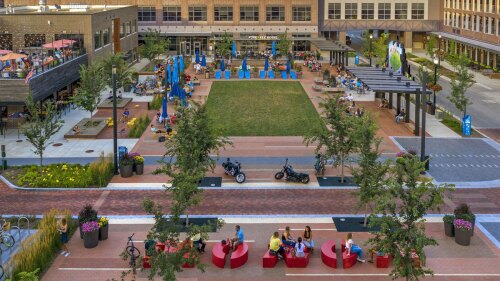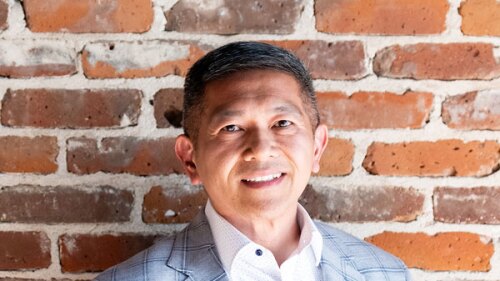An estimated 29 million people struggle to afford quality health care in the United States, with 11 percent of adults considered “cost desperate” and underserved in supply-constrained environments. To expand access and expedite health care to these communities, providers are converting vacant properties into much-needed outpatient facilities, tracking toward an estimated 10.6 percent growth rate over the next five years. Innovative design and construction ingenuity bring these projects to life by delivering increased solutions that address the unique needs of each community.
Such is the case with SAC Health Brier Campus, a former banking call center that sat vacant after the Covid pandemic but was recently transformed into a 280,000 square foot (26,000 sq m) “healing oasis” in San Bernardino, California.
Ranked as one of America’s unhealthiest cities, San Bernardino has long endured health disparities linked to a range of socioeconomic challenges, such as unemployment and high rates of poverty. Aiming to provide comprehensive, high-quality care and support to underserved populations through culturally responsive and patient-centered approaches, SAC Health has provided a haven for health care since Brier Campus’ opening in June 2025.
A tight schedule as challenge and advantage
Adaptive reuse can be challenging, but, in this case, it was clear from the outset of the project that the existing shell would allow our design-build team from Perkins&Will and BNBuilders the opportunity to do anything we needed in terms of layout and design, given its huge open floor plan, generous structural grid, and even a gurney-sized elevator. It was perfect.
But there was a catch.
The project had to be delivered in 16 months, eight months sooner than typical projects of this scale. Failing to meet that deadline would have an adverse effect on SAC Health’s reimbursements from Medicare, which covers most patient costs alongside Medicaid. We accepted the challenge, and we got to work to map out a plan.
We decided upon a modular design for several reasons. First, we always push standardization and modularization, so that the buildout works for the provider’s initial need and in the future. Too often, designs are built only for immediate use, and that does not always allow for any evolution or long-term value.
The best way to make a project flexible is to make every clinic module the same. Doing so allows providers to move people around, and staff can adopt consistent workflows. Furthermore, our compressed timeline required us to complete our schematic design in one month and design development in two months. The fastest way for us to design this project was to do it once and repeat it. As a bonus, speeding up the construction schedule and minimizing the number of contractor questions helped at each step of the way.
The only significant problem we encountered with the existing building was a three-inch raised access floor that had all the cabling underneath, so we had to come up with a way to infill those three inches of floor that didn’t add weight. We couldn’t just pour concrete, as that would have changed all the structural calculations of the building. Such a step would have required structural reinforcement, plus a different review and permitting process, making it impossible to stay within budget and meet our expedited delivery deadline.
We worked with KPFF and BNBuilders, and with other trade partners, for several months to come up with a strategy using Styrofoam, hat channels, plywood, and a light leveling compound on top, which resulted in the building being delivered four days early and under budget. This outcome is cause for celebration for SAC Health; the extended team of designers, engineers and builders; and, mostly importantly, for the residents of San Bernardino, due to the positive impact on their community.
Local inspirations and aspirations
In stark contrast to the poor health outcomes in San Bernardino, their neighbors just south of the freeway, in Loma Linda, live in the United States’ only official Blue Zone—an area where longevity is appreciably higher than the national average, and a substantial proportion of the populace lives more than 100 years.
This circumstance provided everyone involved in the project with great inspiration, and aspiration, as this community has healing traditions through both Indigenous people and the current populace that lives nearby.
SAC Health’s Brier Campus offers a wide range of services with the goal of increasing access to clinical care, expanded resources, and specialty care, allowing for 300,000 patient visits in the next five years. The company is also consolidating administrative staff to this building for greater efficiency and collaboration.
Here is a breakdown of how the space will be used to serve patients:
- 158,000 square feet (14,680 sq m) of clinical, dental, behavioral health, and primary and specialty care services
- 88,000 square feet (8,175 sq m) for nonclinical staff support service
- 4,000 square feet (372 sq m) for a community resource center
- 30,000 square feet (2,787 sq m) of express care for the community
Based on the modular design, the clinics can scale up and down, based upon the ongoing needs of the community. Our goal all along was to make the facility as futureproof as humanly possible.
SAC Health, the largest specialty-based and teaching Federally Qualified Health Center in the United States, has several clinics throughout the Inland Empire, but this project presented a unique opportunity to strategically design and reflect the organization’s commitment to the community. We found inspiration in the beliefs of the Yuhaaviatam Tribe, Indigenous people in San Bernardino, whose legends often portray an arrowhead pointing to the nearby mountain’s healing spring waters.
The community is very connected spiritually, so we wanted to create an environment with tactile finishes and natural materials that would reinforce the connection within native land and make them feel at home. Good design doesn’t have to be expensive. The goal is to provide a dignified environment to treat people and instill trust.
Key takeaways
The fact that the project employs adaptive reuse in a transit-centric location was critical. The approach was to reuse most of the existing infrastructure, mechanical systems, and building skin and to minimize any unnecessary intervention with construction, significantly reducing the amount of landfill and carbon emissions from a project of this scale. The building is remarkable in terms of regeneration and preservation of resources.
The property sat empty for several years, and the completed building is a great way to make use of the space in a cost-effective way and expand much needed community resources and medical services with minimal impact on their carbon footprint.
The Brier Campus provides much-needed space not only to expand SAC Health’s ability to see more patients but also to offer a full range of health care services in one location and streamline the patient experience in a modern facility with the latest equipment and technology.

![20250517 PW - SAC Health - 02 web[1].jpg](https://cdn-ul.uli.org/dims4/default/26e0204/2147483647/strip/true/crop/2500x1664+0+0/resize/1440x958!/quality/90/?url=https%3A%2F%2Fk2-prod-uli.s3.us-east-1.amazonaws.com%2Fbrightspot%2F07%2F06%2F6a84cb3148b78f5e1c660a2877a9%2F20250517-pw-sac-health-02-web1.jpg)
![20250517 PW - SAC Health - 16 web[1].jpg](https://cdn-ul.uli.org/dims4/default/b618b69/2147483647/strip/true/crop/2500x1408+0+128/resize/1000x563!/quality/90/?url=https%3A%2F%2Fk2-prod-uli.s3.us-east-1.amazonaws.com%2Fbrightspot%2Fbc%2F88%2Fee91cbc742fda3f233034ee76119%2F20250517-pw-sac-health-16-web1.jpg)
![20250517 PW - SAC Health - 18 web[1].jpg](https://cdn-ul.uli.org/dims4/default/06402da/2147483647/strip/true/crop/2500x1408+0+128/resize/1000x563!/quality/90/?url=https%3A%2F%2Fk2-prod-uli.s3.us-east-1.amazonaws.com%2Fbrightspot%2F7c%2F46%2F558d7d3a42a284686b7b7f58e35b%2F20250517-pw-sac-health-18-web1.jpg)



